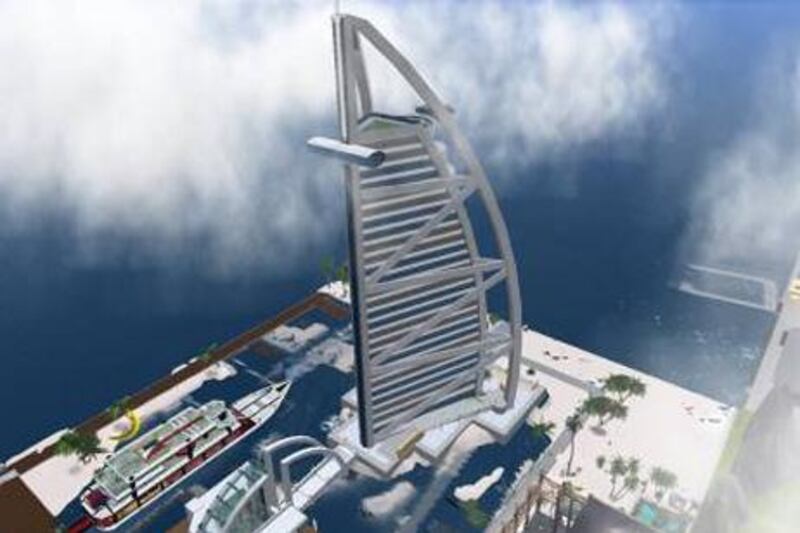DUBAI // Some of Dubai's biggest and most famous structures will be turned into pixels in a computer game aimed at promoting the emirate.
A virtual island containing replicas of structures including the Burj Al Arab and Madinat Jumeirah, are part of a marketing proposal submitted by a German firm to the luxury hotelier Jumeirah Group. They hope the simulation, to appear on the virtual-world computer game Second Life, will drive more tourists to Jumeirah's hotels in particular, as well as the Emirates as a whole.
The project is the brainchild of Angela Gelenbe, who has been a travel agent in Leipzig for 20 years and has run a virtual holiday firm in Second Life for the past three. She already owns a hotel in the game with a similar design to the Burj Al Arab which has proved popular among players.
"Lots of people see the Burj here and then go and visit the real-world Burj Al Arab," said Ms Gelenbe of the virtual version. "I thought that perhaps there was a market here for Jumeirah to exploit." Ms Gelenbe, whose in-game persona is named Angie Ling, said her virtual tourism business has helped to drive customers to her real-life company.
Second Life, launched in 2003 by Linden Lab, is an online game where individuals create images of themselves called avatars and interact with each other in electronic worlds. Users can create their own buildings, which can be purchased in Linden dollars, an in-world currency that can be converted directly into US dollars through an exchange.
Among a list of possible game strategies is to create an island called "Dubai" with virtual replicas of well-known hotels. Real-world tour operators such as Thomas Cook and TUI can then be invited to rent out the rooms to virtual residents while at the same time marketing their own tours to Dubai.
Currently, Ms Gelenbe rents out suites in her own 10-room Burj hotel for a minimal rate of 200 Linden dollars a week, or Dh2.8 at current exchange rates. While her virtual profit is minimal, the exposure helps her actual business gain clients, she said.
Second Life captured the popular imagination when the developer Anshe Chung became the first person to become a real-world millionaire through selling virtual property on the game in 2006. At the peak of its popularity, brands as varied as IBM and Adidas set up a presence in Second Life and Reuters established a news bureau with a beat reporter.
Hoteliers also got into the act, with Starwood Hotels establishing its first Aloft branded hotel in the game to get user feedback on the design. Many corporations have since withdrawn and some experts say the game's commercial appeal has waned.
Nick Abrahams, a corporate lawyer for Norton Rose in Sydney, said: "Two or three years ago I was doing a lot of work for corporates who were interested in Second Life. The corporates who were involved with it have since pulled back. The problem is that there doesn't seem to be the right kind of people, nor a critical mass of people, to make it work."
However, the success of any in-game marketing campaign is largely dependent on how it is pitched and corporate defections in recent years may actually represent an opportunity, said Kimberly Rufer-Bach, the owner of a Second Life marketing firm called The Magicians.
She said its success depends on the "exact market targeted and the approach taken."






